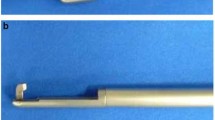Abstract
Purpose
In total gastrectomy, Roux-en-Y reconstruction with esophagojejunal anastomosis has been widely used in gastrointestinal reconstruction. In the case of anastomotic leakage of RY reconstruction, esophagojejunal anastomosis should be paid attention, and esophageal fragility is considered the reason for the leakage. Here, we introduce an atraumatic and innovative technique for esophagojejunostomy.
Methods
We prospectively performed routine novel esophagojejunal anastomosis using circular stapler device and reviewed the records of 14 consecutive patients with gastric cancer who underwent open total gastrectomy at Kitasato University Hospital from April 2019 to March 2020. By placing about 10 stay sutures around the entire esophageal stump, the esophageal stump can be opened to the maximum diameter. The forceps gras** the tissue was not necessary for these procedures, consequently preventing either tears the esophageal stump tissue or narrowing the esophageal lumen.
Results
These 14 cases were far advanced cases of gastric cancer, 6 cases of splenectomy and 3 cases of distal pancreatectomy. No technical problems such as esophageal tear were observed in all cases. Postoperative complications were observed in 6 patients (42.9%), and their contents varied. However, they all improved conservatively. Regarding anastomotic complications, anastomotic leakage of Clavien-Dindo-II was observed in one case, but it improved conservatively.
Conclusion
Our new atraumatic anastomosis technique could abolish problems such as tear of esophagus wall due to introduce a larger-sized anvil, trauma of esophageal wall by gras** with forceps such as Alice or Babcock. Consequently, the atraumatic and innovative technique might make the esophagojejunostomy safe. This method might prevent anastomotic leakage and other complications effectively.


Similar content being viewed by others
References
Sitarz R, Skierucha M, Mielko J et al (2018) Gastric cancer: epidemiology, prevention, classification, and treatment. Cancer Manag Res 10:239–248
Kurokawa Y, Katai H, Fukuda H et al (2008) Phase II study of laparoscopy-assisted distal gastrectomy with nodal dissection for clinical stage I gastric cancer: Japan Clinical Oncology Group Study JCOG0703. Jpn J Clin Oncol 38(7):501–503
Hiki N, Katai H, Mizusawa J et al (2018) Long-term outcomes of laparoscopy-assisted distal gastrectomy with suprapancreatic nodal dissection for clinical stage I gastric cancer: a multicenter phase II trial (JCOG0703). Gastric Cancer 21(1):155–161
Katai H, Mizusawa J, Katayama H et al (2019) Single-arm confirmatory trial of laparoscopy-assisted total or proximal gastrectomy with nodal dissection for clinical stage I gastric cancer: Japan Clinical Oncology Group study JCOG1401. Gastric Cancer 22(5):999–1008. https://doi.org/10.1007/s10120-019-00929-9
Sowa M, Kato Y, Nakanishi I et al (1992) Complications of total gastrectomy for gastric cancer–with special reference to anastomotic failure. Anticancer Res 12(5):1427–1430
Schietroma M, Cecilia EM, Carlei F et al (2013) Prevention of anastomotic leakage after total gastrectomy with perioperative supplemental oxygen administration: a prospective randomized, double-blind, controlled, single-center trial. Ann Surg Oncol 20(5):1584–1590
Nomura S, Sasako M, Hitoshi Katai H et al (2000) Decreasing complication rates with stapled esophagojejunostomy following a learning curve. Gastric Cancer 3(2):97–101
Watanabe M, Miyata H, Gotoh M et al (2014) Total gastrectomy risk model: data from 20,011 Japanese patients in a nationwide internet-based database. Ann Surg 260(6):1034–1039
Hiki N, Fukunaga T, Yamaguchi T et al (2007) Laparoscopic esophagogastric circular stapled anastomosis: a modified technique to protect the esophagus. Gastric Cancer 10:181–186
Nishikawa K, Yanaga K, Kashiwagi H et al (2010) Significance of intraoperative endoscopy in total gastrectomy for gastric cancer. Surg Endosc 24(10):2633–2636
Mariette C, De Botton M-L, Piessen G (2012) Surgery in esophageal and gastric cancer patients: what is the role for nutrition support in your daily practice? Ann Surg Oncol 19(7):2128–2134
Makuuchi R, Irino T, Tanizawa Y et al (2019) Esophagojejunal anastomotic leakage following gastrectomy for gastric cancer. Surg Today 49(3):187–196
Marano L, Porfidia R, Pezzella M et al (2013) Clinical and immunological impact of early postoperative enteral immunonutrition after total gastrectomy in gastric cancer patients: a prospective randomized study. Ann Surg Oncol 20:3912–3918
Author information
Authors and Affiliations
Corresponding author
Ethics declarations
Ethics approval
All procedures performed in studies involving human participants were in accordance with the 1964 Declaration of Helsinki and its later amendments or comparable ethical standards.
Informed consent
Informed consent was obtained from all participants included in the study.
Conflict of interest
The authors declare no competing interests.
Additional information
Publisher's note
Springer Nature remains neutral with regard to jurisdictional claims in published maps and institutional affiliations.
Supplementary Information
Below is the link to the electronic supplementary material.
Supplementary file1 (MP4 387642 KB)
Rights and permissions
About this article
Cite this article
Niihara, M., Hiki, N., Hosoda, K. et al. Improved anastomotic technique for esophagojejunal anastomosis using circular stapler. Langenbecks Arch Surg 407, 353–356 (2022). https://doi.org/10.1007/s00423-021-02417-0
Received:
Accepted:
Published:
Issue Date:
DOI: https://doi.org/10.1007/s00423-021-02417-0




